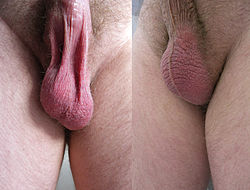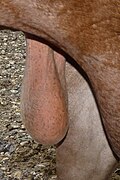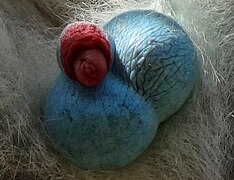Scrotum
In most terrestrial mammals, the scrotum (pl.: scrotums or scrota; possibly from Latin scortum, meaning "hide" or "skin")[1][2] or scrotal sac is a part of the external male genitalia located at the base of the penis. It consists of a sac of skin containing the external spermatic fascia, testicles, epididymides, and vasa deferentia. The scrotum will usually tighten when exposed to cold temperatures.
The scrotum is homologous to the labia majora in females.
Structure
[edit]
In regards to humans, the scrotum is a suspended dual-chambered sac of skin and muscular tissue containing the testicles and the lower part of the spermatic cords. It is located behind the penis and above the perineum. The perineal raphe is a small, vertical ridge of skin that expands from the anus and runs through the middle of the scrotum front to back. The scrotum is also a distention of the perineum and carries some abdominal tissues into its cavity including the testicular artery, testicular vein, and pampiniform plexus.
Nerve supply
[edit]| Nerve | Surface[3] |
|---|---|
| Genital branch of genitofemoral nerve | anterolateral |
| Anterior scrotal nerves (from ilioinguinal nerve) | anterior |
| Posterior scrotal nerves (from perineal nerve) | posterior |
| Perineal branches of posterior femoral cutaneous nerve | inferior |
Blood supply
[edit]| Blood vessels[4] | |
|---|---|
| Anterior scrotal artery | originates from the deep external pudendal artery[5] |
| Posterior scrotal artery | |
| Testicular artery |
Skin and glands
[edit]The skin on the scrotum is more highly pigmented in comparison to the rest of the body. The septum is a connective tissue membrane dividing the scrotum into two cavities.[6]
Lymphatic system
[edit]The scrotal lymph initially drains into the superficial inguinal lymph nodes, this then drains into the deep inguinal lymph nodes. The deep inguinal lymph nodes channel into the common iliac, which ultimately releases lymph into the cisterna chyli.
| Lymphatic vessels[7] | |
|---|---|
| Superficial inguinal lymph nodes | |
| Popliteal lymph nodes |
Asymmetry
[edit]One testis is typically lower than the other, which is believed to function to avoid compression in the event of impact; in humans, the left testis is typically lower than the right.[8] An alternative view is that testis descent asymmetry evolved to enable more effective cooling of the testicles.[9]
Internal structure
[edit]
Additional tissues and organs reside inside the scrotum and are described in more detail in the following articles:
Development
[edit]
During the fifth week after fertilization, the genital ridge grows behind the peritoneal membrane. By the sixth week, string-like tissues called primary sex cords form within the enlarging genital ridge. Externally, a swelling called the genital tubercule appears over the cloacal membrane.
Testosterone secretion starts during week eight, reaches peak levels during week 13 and eventually declines to very low levels by the end of the second trimester. The testosterone causes the masculinization of the labioscrotal folds into the scrotum. The scrotal raphe is formed when the embryonic, urethral groove closes by week 12.[10]
Scrotal growth and puberty
[edit]Though the testes and scrotum form early in embryonic life, sexual maturation begins upon entering puberty. The increased secretion of testosterone causes the darkening of the skin and development of pubic hair on the scrotum.[11]
Function
[edit]The scrotum regulates the temperature of the testicles and maintains it at 35 degrees Celsius (95 degrees Fahrenheit), i.e. two or three degrees below the body temperature of 37 degrees Celsius (99 degrees Fahrenheit). Higher temperatures affect spermatogenesis.[12] Temperature control is accomplished by the smooth muscles of the scrotum moving the testicles either closer to or further away from the abdomen dependent upon the ambient temperature. This is accomplished by the cremaster muscle in the abdomen and the dartos fascia (muscular tissue under the skin that makes the scrotum appear wrinkly).[11]
During sexual arousal, the scrotum will also tighten and thicken in the course of penile erection.[13]
Having the scrotum and testicles situated outside the abdominal cavity may provide additional advantages. The external scrotum is not affected by abdominal pressure. This may prevent the emptying of the testes before the sperm were matured sufficiently for fertilization.[12] Another advantage is it protects the testes from jolts and compressions associated with an active lifestyle. The scrotum may provide some friction during intercourse, helping to enhance the activity.[14] The scrotum is also considered to be an erogenous zone.[15]
Society and culture
[edit]Common slang terms for the scrotum are ballsack, nutsack, and teabag.
Some men will get a piercing on the skin of the scrotum, any of which is called a hafada (e.g., scrotal ladder). Side-to-side or front-to-back piercings that pass through the scrotum are known as transscrotal piercings.
Scrotoplasty is a sex reassignment surgery that creates a scrotum for trans men using tissue from the labia majora, or a plastic surgery that repairs or reconstructs the scrotum.
Other animals
[edit]A scrotum is present in all boreoeutherian land mammals except hippopotamuses, rhinoceroses, hedgehogs, moles, pangolins, tapirs, and numerous families of bats and rodents.[16] The anus is separated from the scrotum by the perineum in these mammals. The testicles remain in the body cavity in all other vertebrates, including cloacal animals.[17]
Unlike placentals, some male marsupials have a scrotum that is anterior to the penis,[18][19][20][21] which is not homologous to the scrotum of placentals,[22] although there are several marsupial species without an external scrotum.[23]
The scrotum is also absent in marine mammals, such as whales, dolphins, and seals,[24] as well as in lineages of other land mammals, such as the afrotherians (elephants, aardvarks, etc.), xenarthrans (armadillos, anteaters, and sloths),[25][16] and monotremes.[26][27]
-
Scrotum of a bull
-
Scrotum of a kangaroo
-
Scrotum of a red deer
-
Scrotum of a jaguar
-
Scrotum of a camel
-
Scrotum of a vervet monkey
-
Scrotum of a giraffe
Clinical significance
[edit]A study has indicated that use of a laptop computer positioned on the lap can negatively affect sperm production.[28][29]
Diseases and conditions
[edit]The scrotum and its contents can develop many diseases and can incur injuries. These include:
- Candidiasis (yeast infection)
- Sebaceous cyst
- Epidermal cyst
- Hydrocele testis
- Hematocele
- Molluscum contagiosum
- Spermatocele
- Paget's disease of the scrotum[30]
- Varicocele - enlargement of the pampiniform venous complex
- Inguinal hernia
- Epididymo-orchitis
- Testicular torsion
- Pruritus scroti - irritation of the scrotum (itchiness)
- Genital warts - sexually transmitted infection
- Testicular cancer
- Dermatitis
- Undescended testes
- Chyloderma - swollen scrotum caused by a lymphatic obstruction
- Mumps
- Scabies
- Herpes - sexually transmitted infection
- Pubic lice
- Chancroid (Haemophilus ducreyi) - sexually transmitted infection
- Chlamydia (Chlamydia trachomatis) - sexually transmitted infection
- Gonorrhea (Neisseria gonorrhoeae) - sexually transmitted infection
- Granuloma inguinale or (Klebsiella granulomatis)
- Syphilis (Treponema pallidum) - sexually transmitted infection
- Scrotal eczema
- Scrotal psoriasis disease
- Riboflavin deficiency
- Chimney sweeps' carcinoma (scrotal cancer)
See also
[edit]- Retroperitoneal lymph node dissection
- Scrotal infusion, a temporary form of body modification
- Testicular self-examination
Bibliography
[edit]- Books
 This article incorporates text in the public domain from page 1237 of the 20th edition of Gray's Anatomy (1918)
This article incorporates text in the public domain from page 1237 of the 20th edition of Gray's Anatomy (1918)- Van De Graaff, Kent M.; Fox, Stuart Ira (1989). Concepts of Human Anatomy and Physiology. Dubuque, Iowa: William C. Brown Publishers. ISBN 978-0697056757.
- Elson, Lawrence; Kapit, Wynn (1977). The Anatomy Coloring Book. New York: Harper & Row. ISBN 978-0064539142.
- "Gross Anatomy Image". Medical Gross Anatomy Atlas Images. University of Michigan Medical School. 1997. Retrieved 2015-02-23.
- Berkow, Robert (1977). The Merck Manual of Medical Information; Home Edition. Whitehouse Station, New Jersey: Merck Research Laboratories. ISBN 978-0911910872.
References
[edit]- ^ van Driel, Mels (2010). Manhood: The Rise and Fall of the Penis. Reaktion Books. p. 11. ISBN 978-1-86189-708-4. Retrieved October 14, 2023.
- ^ Spiegl, Fritz (1996). Fritz Spiegl's Sick Notes: An Alphabetical Browsing-Book of Derivatives, Abbreviations, Mnemonics and Slang for Amusement and Edification of Medics, Nurses, Patients and Hypochondriacs. Taylor & Francis. p. 142. ISBN 978-1-85070-627-4. Retrieved October 14, 2023.
- ^ Moore, Keith; Anne Agur (2007). Essential Clinical Anatomy, Third Edition. Lippincott Williams & Wilkins. p. 132. ISBN 978-0-7817-6274-8.
- ^ Elson & Kapit 1977.
- ^ antthigh at The Anatomy Lesson by Wesley Norman (Georgetown University)
- ^ "Scrotum". Encyclopædia Britannica. Retrieved 2015-02-24.
- ^ "VIII. The Lymphatic System. 5. The Lymphatics of the Lower Extremity. Gray, Henry. 1918. Anatomy of the Human Body". Retrieved 2015-02-24.
- ^ Bogaert, Anthony F. (1997). "Genital asymmetry in men" (PDF). Human Reproduction. 12 (1): 68–72. doi:10.1093/humrep/12.1.68. PMID 9043905. Archived from the original (PDF) on 2015-05-28. Retrieved 2015-06-29.
- ^ Gallup, Gordon G.; Finn, Mary M.; Sammis, Becky (2009). "On the Origin of Descended Scrotal Testicles: The Activation Hypothesis". Evolutionary Psychology. 7 (4): 147470490900700. doi:10.1177/147470490900700402.
- ^ Van De Graaff & Fox 1989, pp. 927–931.
- ^ a b Van De Graaff & Fox 1989, p. 935.
- ^ a b Van De Graaff & Fox 1989, p. 936.
- ^ Jequier, Anne M. (2008). Male Infertility: A Guide for the Clinician. Wiley. p. 180. ISBN 978-0-47069-526-5.
- ^ Jones, Richard (2013). Human Reproductive Biology. Academic Press. p. 74. ISBN 9780123821850.
The rear-entry position of mating may allow the scrotum to stimulate the clitoris and, in this way, may produce an orgasm ...
- ^ Redmon, George L. (2002). Sensual for Life. Kensington Publishing Corporation. p. 176. ISBN 978-0-75820-138-6.
- ^ a b Lovegrove, B. G. (2014). "Cool sperm: Why some placental mammals have a scrotum". Journal of Evolutionary Biology. 27 (5): 801–814. doi:10.1111/jeb.12373. PMID 24735476. S2CID 24332311.
- ^ "Science : Bumpy lifestyle led to external testes - 17 August 1996 - New Scientist". New Scientist. Retrieved 2007-11-06.
- ^ Hugh Tyndale-Biscoe; Marilyn Renfree (30 January 1987). Reproductive Physiology of Marsupials. Cambridge University Press. ISBN 978-0-521-33792-2.
- ^ Libbie Henrietta Hyman (15 September 1992). Hyman's Comparative Vertebrate Anatomy. University of Chicago Press. pp. 583–. ISBN 978-0-226-87013-7.
- ^ Menna Jones; Chris R. Dickman; Michael Archer (2003). Predators with Pouches: The Biology of Carnivorous Marsupials. Csiro Publishing. ISBN 978-0-643-06634-2.
- ^ Norman Saunders; Lyn Hinds (1997). Marsupial Biology: Recent Research, New Perspectives. UNSW Press. ISBN 978-0-86840-311-3.
- ^ Patricia J. Armati; Chris R. Dickman; Ian D. Hume (17 August 2006). Marsupials. Cambridge University Press. ISBN 978-1-139-45742-2.
- ^ C. Hugh Tyndale-Biscoe (2005). Life of Marsupials. Csiro Publishing. ISBN 978-0-643-06257-3.
- ^ William F. Perrin; Bernd Würsig; J.G.M. Thewissen (26 February 2009). Encyclopedia of Marine Mammals. Academic Press. ISBN 978-0-08-091993-5.
- ^ "Scrotum". National Institutes of Health. Retrieved 6 January 2011.
- ^ Griffiths, Mervyn (2012-12-02). The Biology of the Monotremes. Elsevier. ISBN 978-0-323-15331-7.
- ^ Hayssen, Virginia; Orr, Teri J. (2017-10-27). Reproduction in Mammals: The Female Perspective. JHU Press. ISBN 978-1-4214-2315-9.
- ^ "Laptops may damage male fertility". BBC News. 2004-12-09. Retrieved 2012-01-30.
- ^ Sheynkin, Yefim; et al. (February 2005). "Increase in scrotal temperature in laptop computer users". Hum. Reprod. 20 (2): 452–455. doi:10.1093/humrep/deh616. PMID 15591087.
- ^ "Paget's disease of the scrotum Symptoms, Diagnosis, Treatments and Causes". RightDiagnosis.com. Retrieved 2015-02-24.
External links
[edit] Media related to Scrotums at Wikimedia Commons
Media related to Scrotums at Wikimedia Commons








